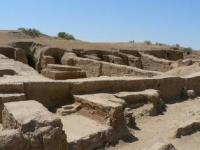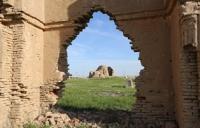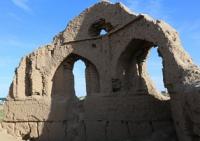You are here
History Termez.



Excursions across Termez.
“For everything in this journey of life we are on, there is a right wing and a left wing: for the wing of love there is anger; for the wing of destiny there is fear; for the wing of pain there is healing; for the wing of hurt there is forgiveness; for the wing of pride there is humility; for the wing of giving there is taking; for the wing of tears there is joy; for the wing of rejection there is acceptance; for the wing of judgment there is grace; for the wing of honor there is shame; for the wing of letting go there is the wing of keeping. We can only fly with two wings and two wings can only stay in the air if there is a balance. Two beautiful wings is perfection. There is a generation of people who idealize perfection as the existence of only one of these wings every time. But I see that a bird with one wing is imperfect. An angel with one wing is imperfect. A butterfly with one wing is dead. So this generation of people strive to always cut off the other wing in the hopes of embodying their ideal of perfection, and in doing so, have created a crippled race”
C. JoyBell C.
Places of interest of Termez.
Central Asia, the vast territory located on the crossroads East West, North South, on the main passage through Eurasia, became the setting place for a diversity of ethnic groups on their way to greener pastures, literally.
The spendid monuments of the cultures they founded have left their traces on this part of the world. The most interesting period in terms of different ethnicities cohabitating, each contributing their share to the social and cultural life, is without a doubt the Bactrian period.
Bactria extended from northern Tajikistan and the territory of present day Surkhandarya in southern Uzbekistan to the north of nowadays Afghanistan. Termez is one of the historical cities of Uzbekistan which is situated in the south part of the country.
It is considered the hottest region in the country. Historical Arabic and Greek data as well as archeological findings evidences that Termez is one of the ancient cities in Uzbekistan, Central Asia.
Its geographic and strategic right place on the trade cross roads between the east and west, the south and north established a base to develop. Additionally, one of the important branches of the Great Silk Road passed through it.
Termez played a significant role in the growth of the ancient civilization of the East. According to the archeological excavation in the fortress part of the ancient Termez and the analysis of manuscripts the city came to existence in the middle of the first millennium.
It was in cultural and commercial relationship with the states such as Sogdiana, Kharezm, Margiana and Parphia. In concordance with the findings, Termez took part in cultural and trade relations very actively.
In the IV - III centuries before the Common Era instead of the ancient fortress of Termez there was an inhabited area. As Hofizi Abruy wrote, the city name had been derived from Bactrian “Taramastha” which meant “a settlement on another bank” and for centuries it had been called with various names such as Antiohia, Demetrias, Tarmid, Tarmiz, Tami, Tamo and etc.
From the X century it was called Termez. In the III - II B.C.E Termez was changed into one of the most developed, cultural, political, and commercial regions of Bactria. All material evidence and findings show that the relation of commodity and money in this area has developed earlier than the other ones of Mavoraunnahr.
Termez thrived greatly during the reign of Kushans. In this period it was broadened in territory and turned into a large city of Northern Bactria. At the same time it was a centre of Buddhism of Kushans’ state.
In the X-XII centuries Termez flourished and was a handicraft and trade center of Tokharistan. At that time its area was more than 500 hectares. A lot of grandiose buildings were constructed in the city.
Alternately Termez was a part of states such as Ghaznavids, Karakhanids, Karakhitais, Seldjukids and Kharezm. It was destroyed by the Mongols in 1220. As per the intimation in “Zafarnama” of Sharafuddin Ali Yazdi the city people had strongly confronted the Mongols and thus it was called “Madinat Ur-Rijol” (means “the city of the braves”).
In the XIV century, Termez was reestablished near the riparian part of Surkhandarya. In 1370 Temur annexed the city as well as the Surkhandarya oasis. In 1407 Termez fortress was rebuilt at the bank of the river by the order of Temurid Halil Sulton. In 1504 - 1505 Shaybaniykhan conquered it.
At last after many invasions the city was totally demolished in the second half of the XVIII century. In 1894 the Russians built a fortress in Pattakesar village named Tuprakkurgan by local people which is about 8 km from the ruins of ancient Termez.
The present day Termez has been rebuilt around the Tuprakkurgan. The construction of the railway of Bukhara-Karshi-Termez effected the economic growth of Termez. The main road which unites Uzbekistan with the neighboring countries such as Afghanistan, Pakistan and India passes through Termez and this plays a significant role in political and economical life of the city.
At present a lot of historical, Islamic and Buddhist monuments and memorials have been preserved. Here below some of them are listed:
Kampir-Tepa fortress of Greek Bactrian period (IV - II B.C.),
Ancient settlement of old Termez (18 km to the north of Termez),
Kara-Tepe Monastery (II - IV c.c.),
Fayaz-Tepe Monastery (I - III c.c.),
Zurmala Tower (I - II c.c.),
Chor Sutun Mosque and Minaret (IX - XI c.c.),
Kyrk-Kyz (out-of-town Palace Country Estate – IX - XIV c.c.),
Palace of Termez rulers (XI - XII c.c.),
Architectural Complex of Khakimi Termezi (X - XV c.c.),
Architectural Ensemble Sultan-Saodat (X - XVIII c.c.),
Kokidora Mausoleum-Khanaka (XVI c.).
Authority:
«The Guidebook on historical and cultural places of interest of the Surkhan-Darya area and the city of Termez». 2011.






